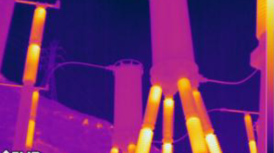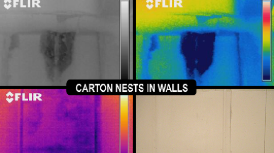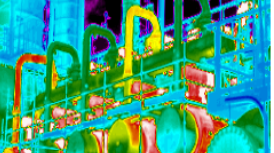Cooling Systems Maintenance by Infrared Thermography
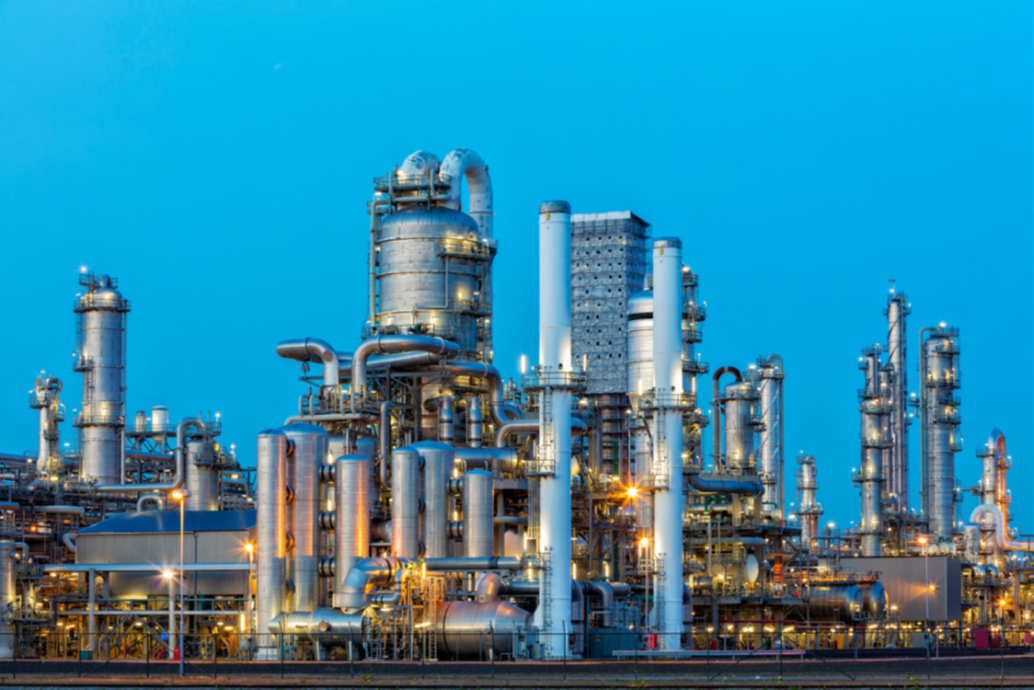
InfraMation 2016 Application Paper Submission
Jean-Michel Demoyer
ABSTRACT
The target of this training is to combine thermography knowhow and cooling systems work; use infrared thermography like a new tool for breakdown and cooling systems maintenance operation; and introduce a new way of maintenance for cooling systems, still present in other field of activity. At each reported trouble on cooling systems, the refrigeration engineer has to troubleshoot it. If the trouble is fluidic, the refrigeration engineer certainly could be able to repair it (except if the repair needs an unavailable spare part).
For example, a condenser fouling or evaporator icing doesn’t need a refrigeration engineer to troubleshoot it. For a conditions requiring service, travel time is expensive and time consuming. Anyone can travel to the customer site, even if they have no knowledge of thermography or cooling systems. Once at the site they can take thermograms. These thermograms contain all the information that the refrigeration engineer requires to plan the optimal maintenance procedures.
INTRODUCTION
Cooling systems are utilized more than ever. The economic aspects associated with the proper and efficient operation of cooling systems has become a real challenge.
Refrigeration is a process of moving heat from one location to another in controlled conditions. The work of heat transport is traditionally driven by mechanical work, but can also be driven by heat, magnetism, electricity, laser, or other means. As you can guess, there are a great variety of design and implementation possibilities for many varied applications. These include:
- Commercial refrigeration for food preservation and transportation
- Industrial cooling for manufacturing processes (cold storage, gas liquefaction, oil refinery, steel industry)
- Air-conditioning in buildings
The refrigeration and air conditioning market is constantly growing: commercial cooling, and the number of supermarket and the cooling volume increases. Economic constraints, energy consumption, environmental impact, and legislative constraints all contribute to changes in cooling system maintenance.
The total or partial breakdown in cooling systems could involve costs like:
- Thermal discomfort in a room that is too warm could impact the efficiency of the working personal and the commercial transactions (sales operation, negotiation).
- Food stored in a warm room could be dangerous to eat, deterioration of the food due to the warm temperature and laws governing hygiene or health might mean the food would have to be disposed of.
These examples illustrated the importance of efficient maintenance of cooling systems. Maintenance is based today only on the refrigeration technician and engineers experience. With the constant rise of the cooling applications, in some areas, there are an insufficient number of refrigeration specialists. For these reasons, MENSOR suggests using infrared thermography to help refrigeration engineers to have efficient systems. MENSOR has designed a methodology to use thermography, detailed in specific training for cooling systems trade.
The targets of this training are:
- Learn to use infrared camera
- Use the thermography as additional tool for maintenance and troubleshooting diagnostics on cooling systems
- Propose a work method for maintenance people already working in another field of activity.
DESCRIPTION OF A COOL SYSTEM
A cooling system is made up of several components:
- The Compressor: Adjusts refrigerant in pressure conditions and temperature to condensate at ambient temperature
- The Condenser: Transfers heat to external media heat from the evaporator
- Pressure reducing valve: Regulates the refrigerant flow control in a low pressure circuit and the overheat of the evaporator
- The Evaporator: Captures the heat the area or media to be cooled
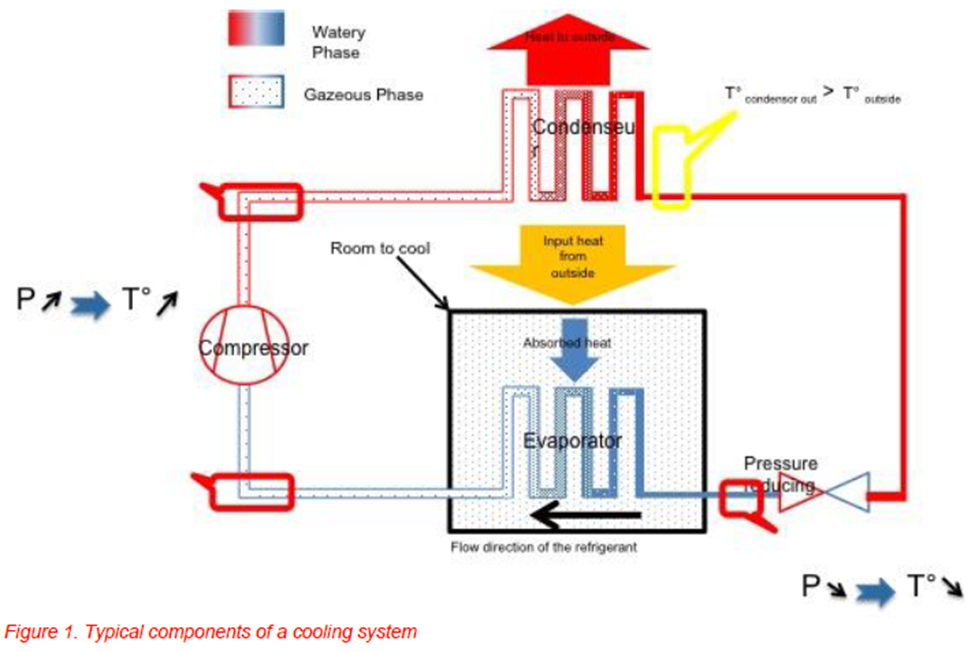
MAINTENANCE OPERATIONS ON A COOL SYSTEM
Frigorific efficiency management (COP)
εf (frigorific efficiency) is equivalent to the performance of a system and used for the cooling systems

Improvement of εf (frigorific efficiency):
- εf ↘ strongly when the compressor does not work at 100%
- εf ↘ strongly with the presence of non-condensate materials
- Defrosting Operation (1 time per hour or 6 times per day)
Management of the refrigerants:
Thermal energy is moving in the frigorific circuit by the refrigerant.
The refrigerants are selected for:
- Thermodynamic properties
- Safety (flammability, toxicity)
- Environmental constraints
- Economic constraints (implementation cost and maintenance)
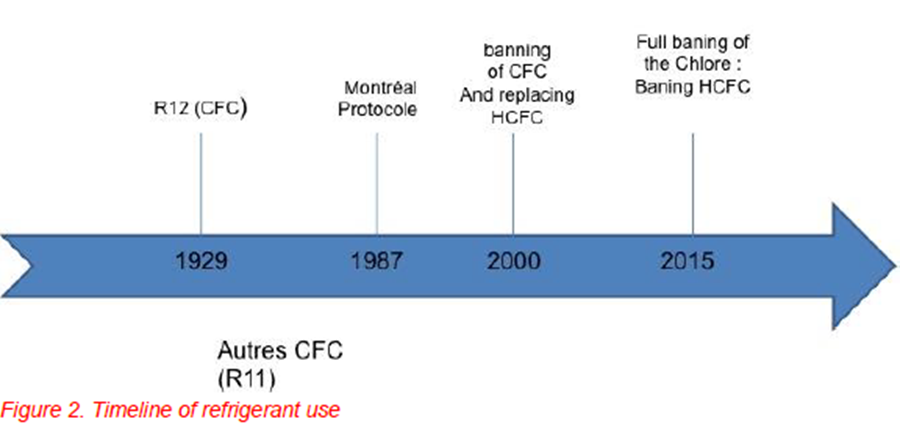
Because the refrigerants are immiscible (incapable of being mixed or blended together), knowledge of refrigerant properties is very important for the maintenance of cooling systems. One of the purposes of the training method is to be able to identify the which refrigerant is being used in a cooling systems by measuring the temperature using thermography. Thermography measures the temperature at the evaporator entrance and the low-pressure value is also necessary. With these 2 values and temperature-pressure data, the unknown refrigerant inside the cool system can be identified.
Hand Touch
The experienced refrigeration engineer estimates the temperature by touching with the hand. This method requires continual practice and does not substitute for a real temperature measurement
Thermometer
The contact thermometer measures only its own temperature. The quality of the contact is responsible for the great uncertainty of the measurement. Making a good measurement can be time consuming and tedious.
Infrared thermography
The infrared camera when used properly can produce a very accurate temperature measurement.
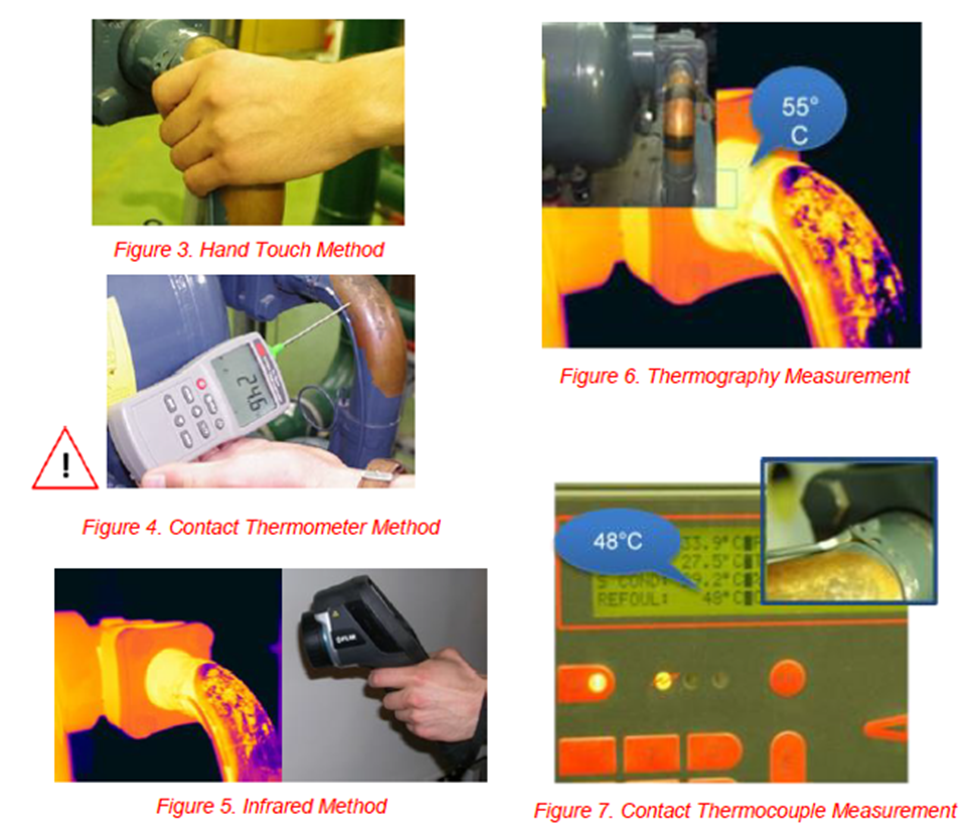
There is a 7°C (12.8°F) difference between the measurement by infrared thermography and the contact thermometer of the backflow compressor temperature.
T°ref = backflow compressor temperature
High power cooling systems are generally set with contact thermometer. The measurement uncertainty from contact thermometers average 5 °C and could be higher.
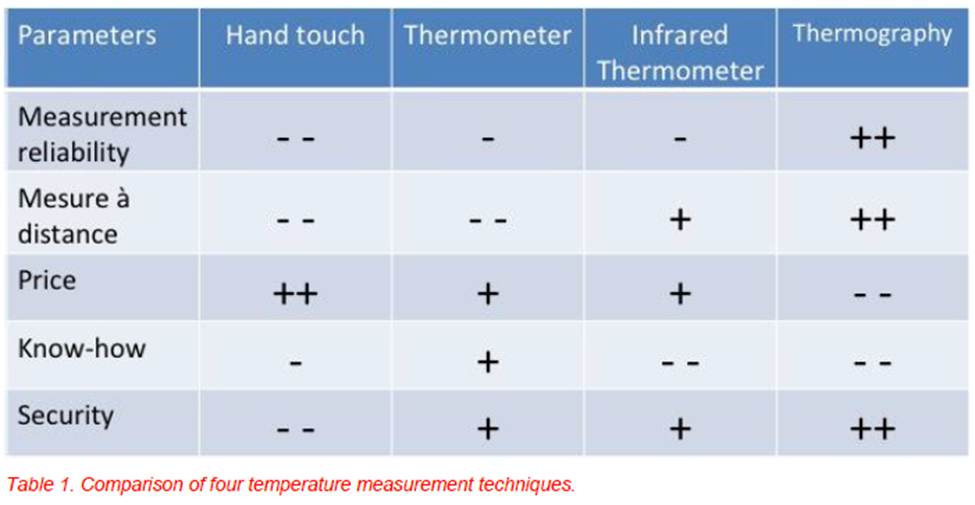
Temperature measurement by Thermography
Thermography is perhaps the most accurate method to measure surface temperature if we take care of some parameters.
Rules for accurate thermography measurements
Check for a known high emissivity at the measurement point. Use an emissivity improver if necessary (black electrical tape)
Check the distance between the measurement point and the infrared camera to make sure you can spatially resolve the measurement area.
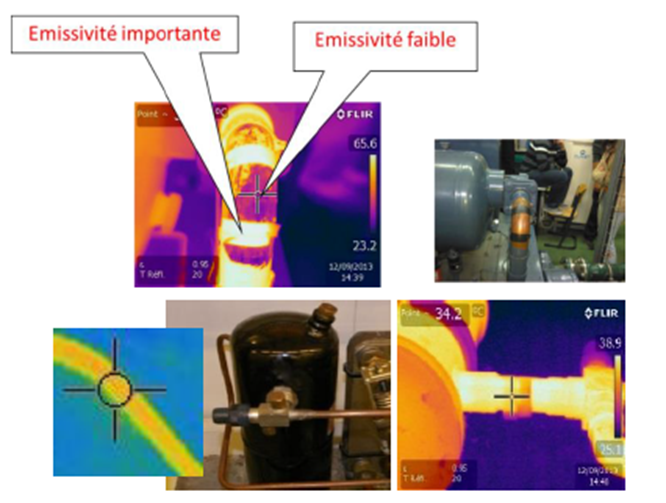

Identification of running breakdown
Failures in a cooling system could have several causes. The problems can come from mechanical, electrical, clogging, and fluidic breakdown. This training will concentrate on fluidic breakdown but the general application of the thermography can treat the other problems.
The Running fluidic breakdown:
- Lower pressure reducing valve
- Fluidic Charge missing
- Pre expansion
- Under sizing Evaporator
- Under sizing Compressor
- Over fluidic charge
- Presence of not condensate material
- Under sizing Condenser
Infrared Thermography for Efficiency Maintenance
Prior art rests on preventive maintenance in the absence of powerful diagnostic means.
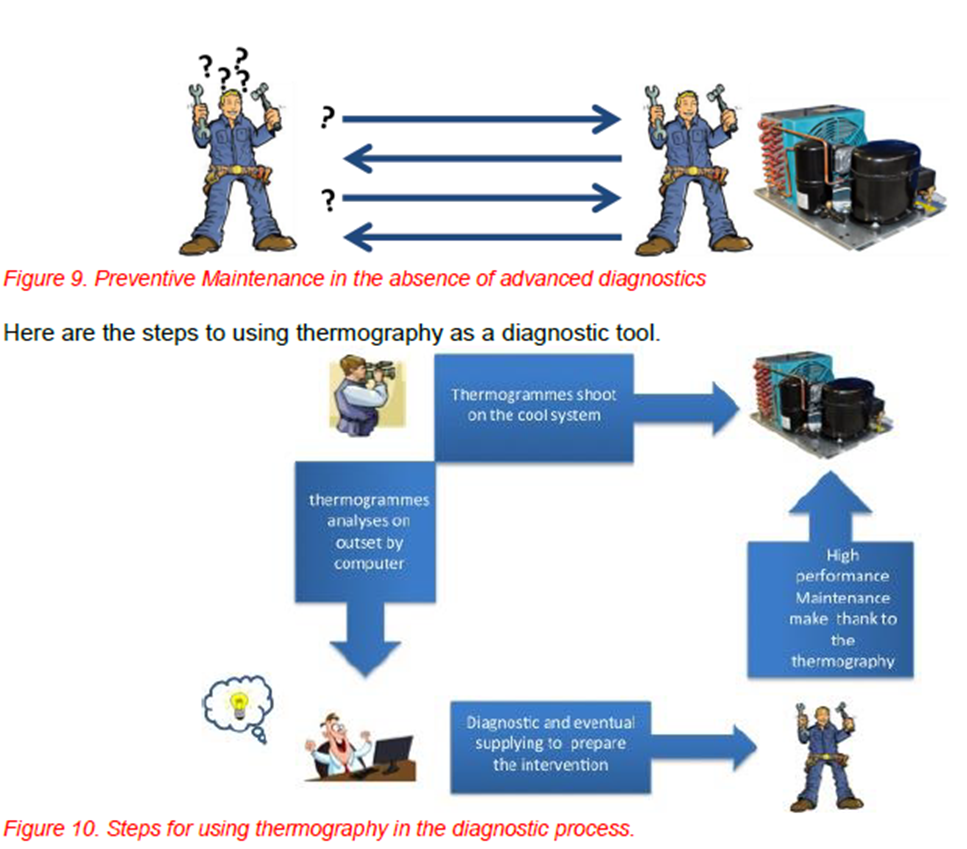
For fast and efficient maintenance:
- Optimization of expert time
- A good quality of your intervention
- An overall check of the cooling system (distribution, electrical, mechanical, clogging)
- Accuracy measurement
For the best competitiveness:
- Optimization of the machines by a best knowledge of the frigorific efficiency
- Remote temperatures measurements allow fast measurement on device out of the reach
- Best image of your company
- Optimization of supplying and business travel
What to Inspect: Components and Parameters
The compressor
- Compressor temperature measurements:
- T° carter
- T° suction
- T° backflow
- T° compressor body (provides good information on the mechanical behavior)
This parameter give the performance of compressor cooling which depends on refrigerant flow
The condenser Temperatures to measure on the condenser:
- T° condenser out
Knowledge about the high pressure and the refrigerant can give us the sub-cooling value.
Sub-cooling depends on the heat exchange quality between the condenser, ambient air, and refrigerant flow.
Filter dehydrator This filter traps the impurity’s and the moisture.
- Temperatures to measure:
- T°entrance filter
- T°filter out
Temperatures at the entrance and exit are depend on the pressure drops in the liquid line.

Pressure reducing valve Temperatures to measure pressure reducing valve:
T°pressure reducing out = T°evaporation
Evaporation temperature depends on the low pressure (function of refrigerant) and change with the refrigerant flow.
T°pressure reducing IN = T°sub-cooling
This information, along with the High-pressure value and the refrigerant, provides the sub-cooling value.
Evaporator Measurement temperatures on the evaporator:
T°evaporator OUT
This information combined with the Low pressure value and the refrigerant gives the over-heating value. The over-heating depends on heat exchange quality between the evaporator and the ambient air, also on the temperatures of both room and cooling air, and the refrigerant flow.
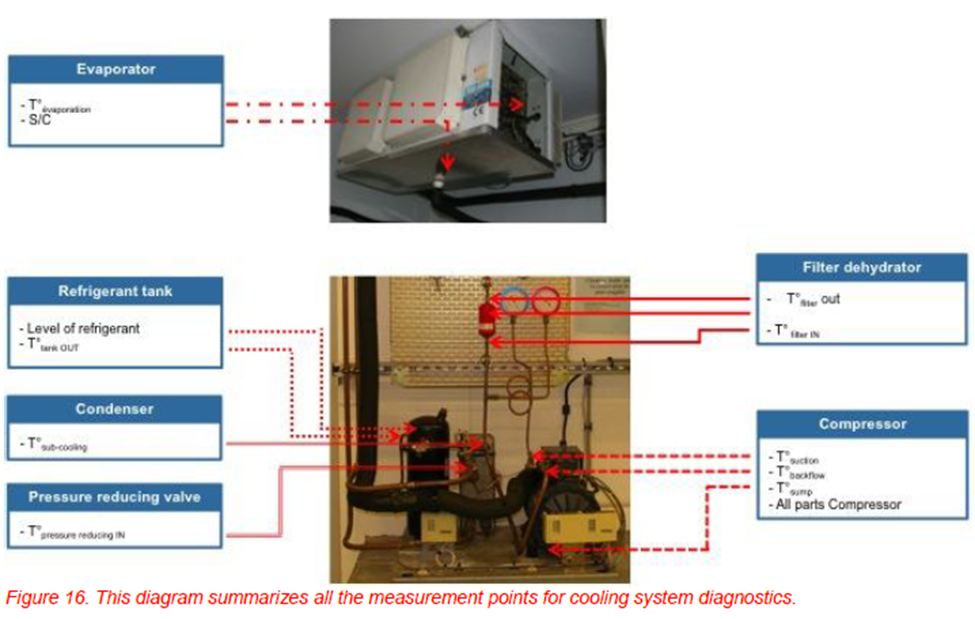
SUMMARY
This training confirms the real added value of infrared thermography in the field of cooling systems diagnostics. With a few thermograms, a complete inspection of a cooling system can be obtained. The follow points can be checked:
- The electrical cabinet to look for electrical hot point (to avoid fire)
- Distribution of cold air
- Look for the mechanical stress on the compressor parts
- Pressure drop on the long line
- System troubleshooting from the temperatures provided by thermography
- Other temperature measurements at every point out of the reach
- More accurate measurement than contact thermometer
This fast and efficient method is optimal for cooling units from from 10KW to 100 KW; and for the negative cold unit; the temperature out of the pressure reducing valve is difficult to get due to frost.
REFERENCES
- La thermographie infrarouge principes-technologies-applications de G.Gaussorgues
- ITC Course manual Level 1
- ITC Course manual Level 2
- ITC Course manual Level 3
STANDARDS
- ISO 7726:1998 Ergonomics of the thermal environment - Instruments for measuring physical quantities
- DIN EN ISO 7730 Corrigendum 1 Ergonomics of the thermal environment -
- ISO 7243:1989 Hot environments - Estimation of the heat stress on workingman,
- ISO 18434-1:2008 Condition monitoring and diagnostics of machines - Thermography - Part 1: General procedures
